E-BIKE 101: LET’S GET STARTED
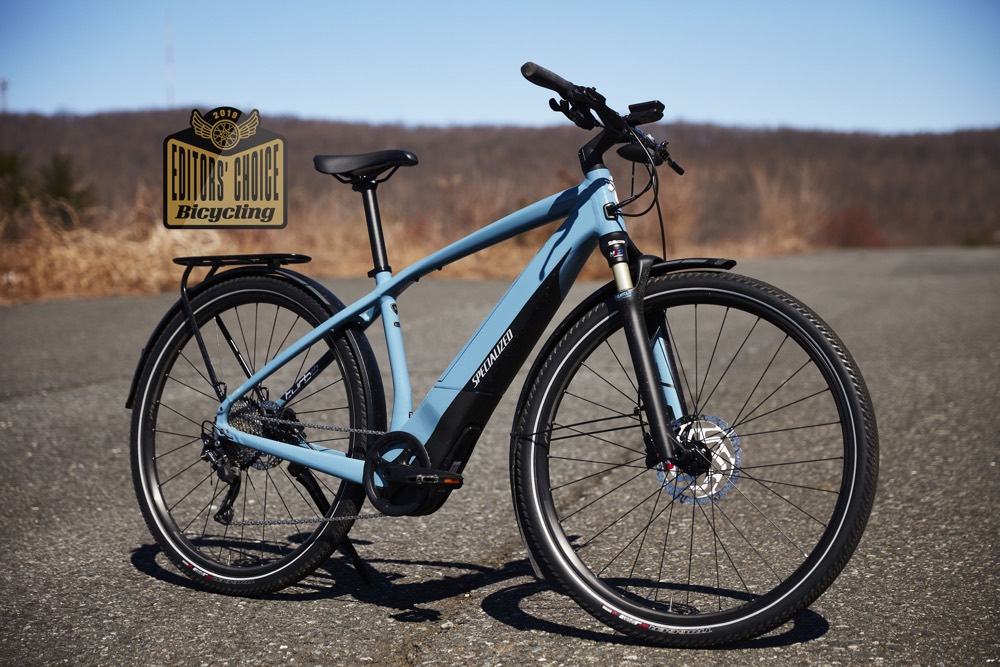
E-bike buzz is huge right now. The upcoming Consumer Electronics Show (CES) is giving e-mobility and e-bikes prominent floor space. Eurobike (Twitter) is spotlighting the expansion of e-bikes, and even Harley Davidson has announced their own upcoming line of e-bikes and balance e-bikes for the little ones. Because of this excitement, I thought it might be a good time to go back to the basics and help our customers so they can make smart buying decisions and not get overwhelmed with the hype. It’s definitely the wild west right now for the e-bike industry.
At Hutch’s Bicycles, we sell e-bikes. Over the past couple of years, we have seen our store sales of e-bikes increasing steadily. And the number of people coming into our store and asking initial questions about e-bikes continues to grow. You don’t have to take my word for it. Simply look around Central Oregon at the types of bikes folks are riding. Walk around a Music on the Green event in Redmond, First Friday in Bend or Picnic in the Park in Prineville and check out the types of bikes locked up to a tree or post. It’s pretty amazing.
This article is a primer, not a deep dive, and the first I will write regarding e-bikes over the coming months. Today I start with the two most common questions I get from our customers and answer them with real-world answers and examples. Not marketing fluff.
Today I will cover:
What exactly is an e-bike?
How far can I ride an e-bike between charges?
Let’s get started…...
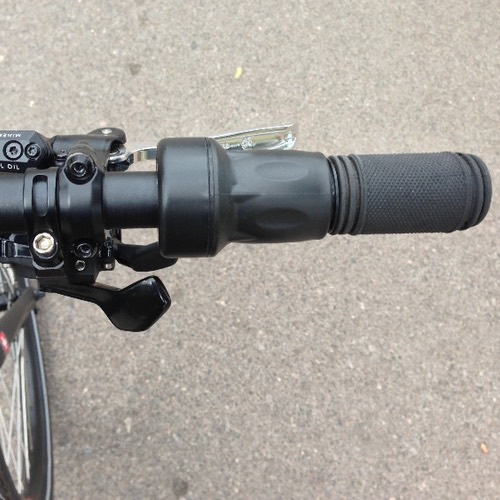
E-Bike twist throttle. Similar to a motorcycle.
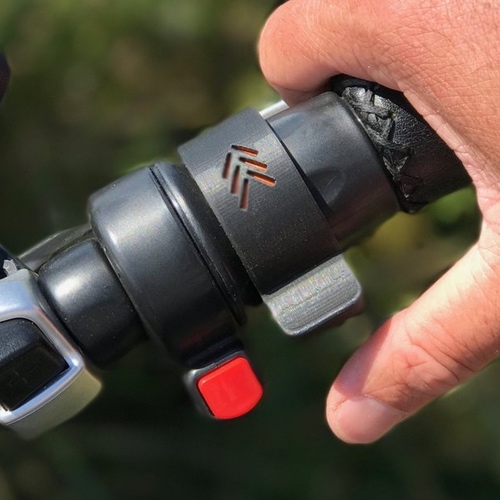
E-Bike thumb throttle similar to some snowmobiles and jet ski watercraft.
WHAT IS AN E-BIKE?
In short, e-bikes are just bikes but with an electric motor and battery attached that help propel the bike forward. They can be pedaled with or without the electric motor assist.
The motor is used to help with pedaling and gives the rider a boost when they need it. Up to a 300% boost, if available. The benefits for riders are they can go longer distances and climb hills like Summit Road or 12th Street up Awbrey Butte in Bend, Oregon, which are crazy steep. Most cyclists wouldn’t attempt riding up them. However, with an e-bike, you can ride up the steepest of city roads like these without breaking a sweat. These bikes have rechargeable batteries, are truly eco-friendly as they emit no harmful CO2 and can go between 20 and 28 mph assisted.
CLASSES AND TYPES OF E-BIKES
E-bikes have three classes:
Class 1: e-bikes that are pedal-assist only, with no throttle, and have a maximum assisted speed of 20 mph.
Class 2: e-bikes that also have a maximum speed of 20 mph but are throttle-assisted similar to a motorcycle or a thumb throttle like a snowmobile.
Class 3: e-bikes that are pedal-assist only, with no throttle, and a maximum assisted speed of 28 mph.
That’s it. You can ride assisted to 20 mph with or without a throttle on your bike. Or ride assisted up to 28 mph but with no throttle. There are no Class 3 throttle e-bikes at this time.
And there are so many different types of e-bikes: cargo e-bikes, cruiser e-bikes, fitness e-bikes, retrofitted e-bikes, crazy looking e-bikes and more. Sometimes I just scratch my head and wonder what the heck they were thinking.
ADDITIONAL FEATURES
Road e-bikes usually have digital displays that let you view your battery level and toggle various ride metrics such as speed, distance, ride time and more. Note that most e-mountain bikes don’t use a display and rely on a smartphone app.
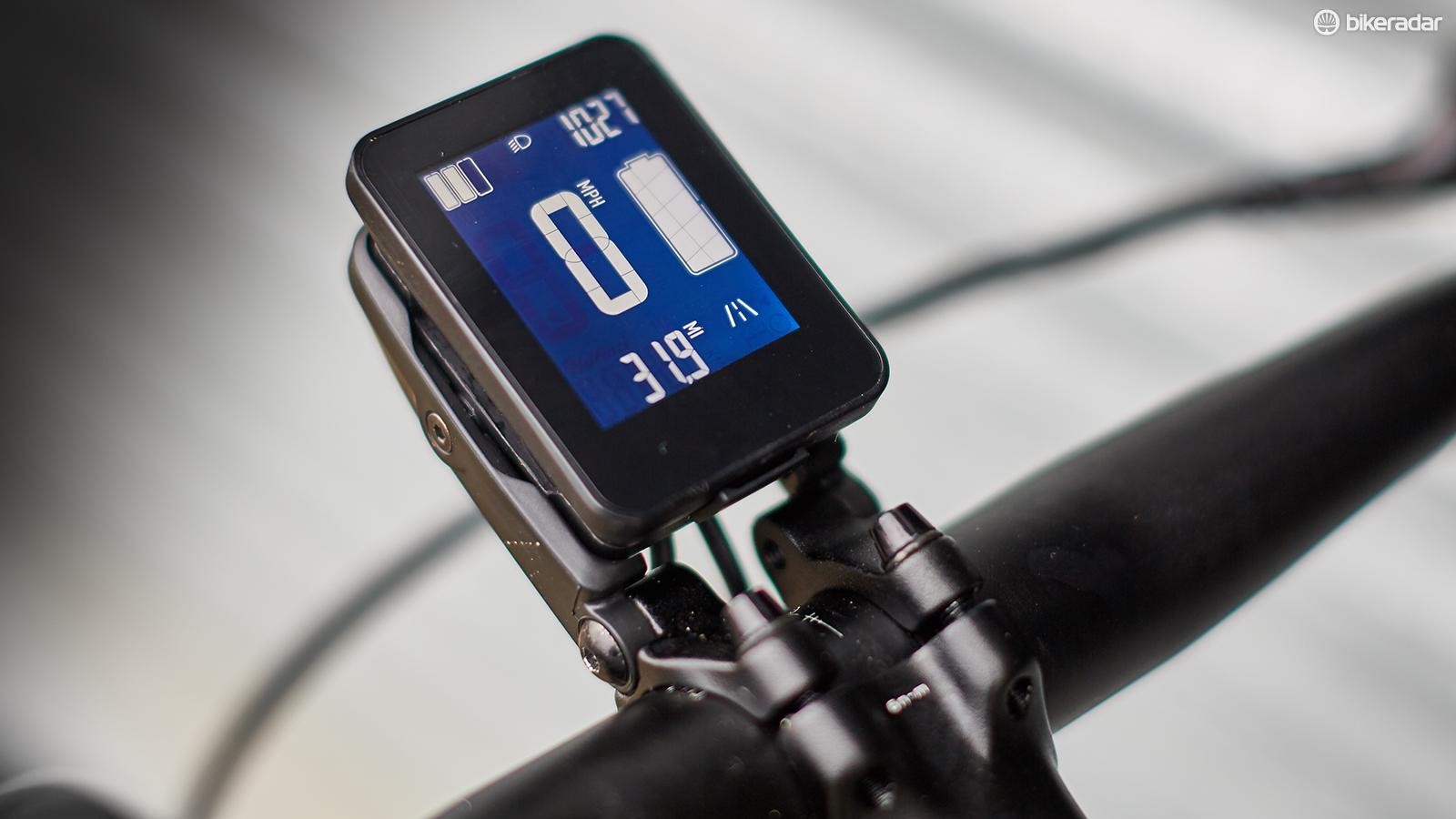
LOW, MEDIUM, AND HIGH PEDAL ASSIST
To clarify a bit more:
Low pedal assist (Vado Eco mode) = you are feeling pretty good on the bike. Low assist provides a little electric assist while you provide more pedal power and get more of a workout. More work, less assist.
Medium pedal assist (Vado Sport mode) = you have a nice tailwind everywhere you go. Medium pedal assist can be a nice balance of your pedal power and the motor power.
High pedal assist (Vado Turbo mode) = you feel like a superhero! High pedal assist is when you want to get somewhere quickly and with minimal effort. This could be useful if you want to get to work without sweating. On the way home, you could use the low pedal assist to work out the stress of the day.
HOW FAR CAN AN E-BIKE GO BETWEEN CHARGES?
If you walk into some stores that sell e-bikes, the answer to the range (how many miles per charge) question can be all over the map. However, there is a really simple answer. Without getting into a granular discussion here about motors, the general rule of thumb for road e-bike buyers is based on the battery’s watt-hours per mile. E-mountain bike (eMTB) calculations are a bit more difficult because of the terrain. I will discuss eMTB’s in a later article.
Let’s use the 2018 Specialized Vado 5.0 for this example. I did a real-world test on this bike in 2017 during the Crater Lake Ride The Rim event. The Vado has a battery listed at 604 watt-hours. The general rule of thumb is 20 to 30 watt-hours per mile. To be optimistic, let’s use 100 watt-hours = 5 miles. So, using simple math, 604/20 = ~ 30 miles of range. Simple enough. Right?
Almost…...
The approximate ~ 30-mile range is “perfect world.” Flat ground, no wind, steady pedaling, etc. If you pedal hard or switch to Turbo mode, your range will drop. If you pedal lightly with a lot of coasting and in Eco mode, then your range will go up. Even starting and stopping affects your range. Rider weight and added accessories and cargo on the bike make a difference as well. But I won’t get into the myriad of variables that affect range in this article as it isn’t important for this discussion.
So how did the test go during the Ride The Rim event on the Specialized Vado? Pretty much as expected.
Our real-world test…..
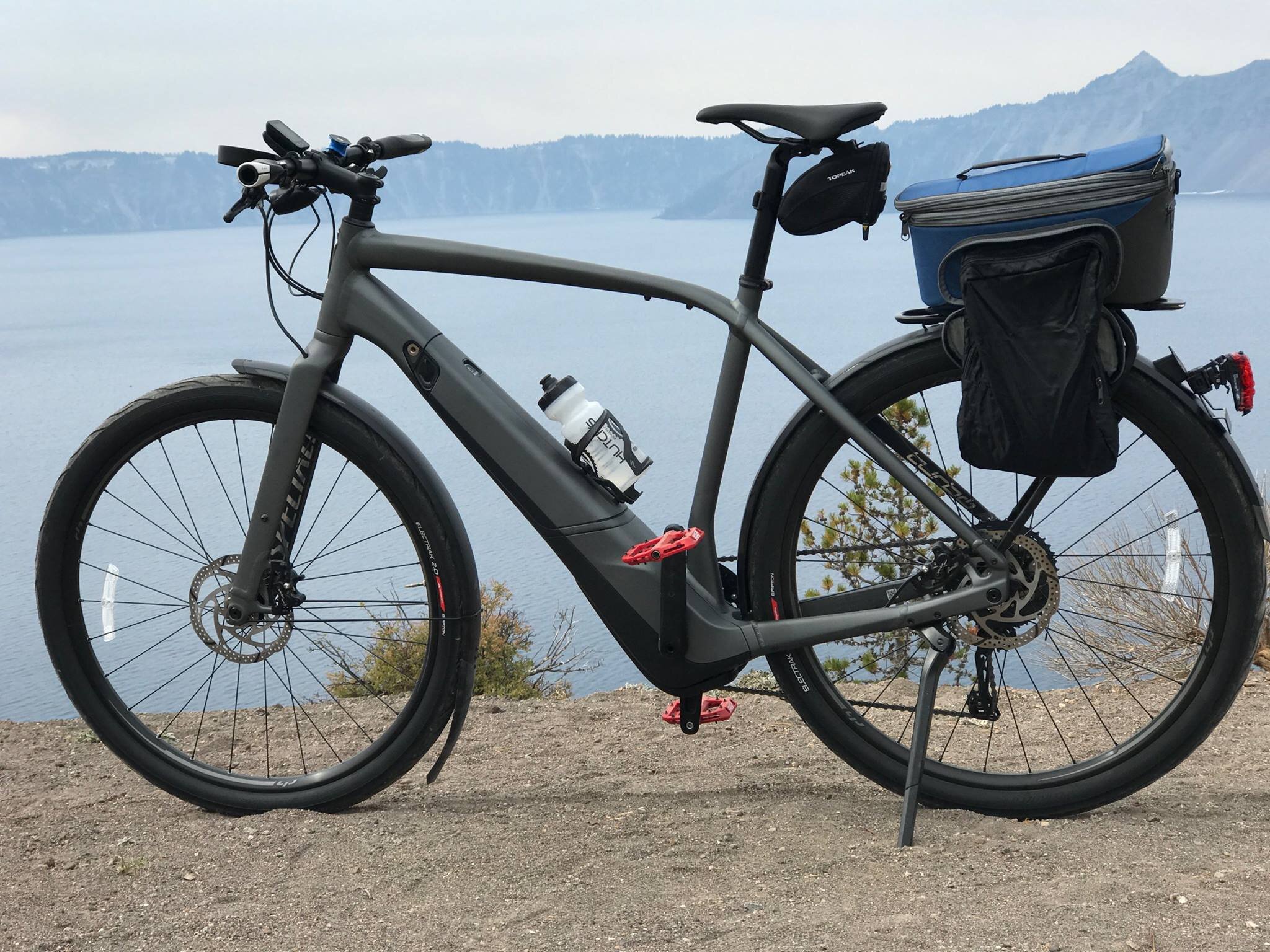
My class 3 Specialized Vado 5.0 at Crater Lake.
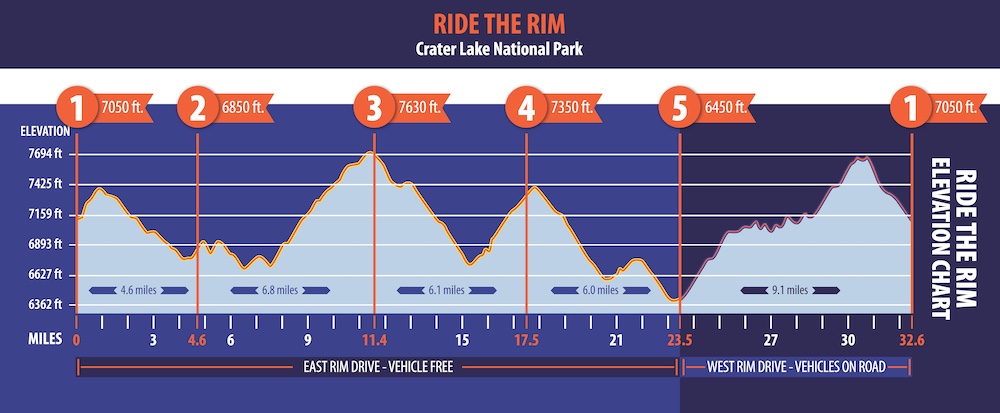
Crater Lake Ride The Rim elevation map and distance.
Here are the details:
Ride Distance: ~ 33 miles
Elevation Gain: ~ 3,600’
Road Condition: Rough and smooth sections on asphalt.
E-bike Settings: ~ 85% Eco mode, 10% Turbo mode and 5% Sport mode
Frame Size: X-Large
Rider Weight: 220 lbs
Rider Height: 6’ 4”
Ride Time: ~ 4 hours
(Original Facebook post here)
I took my time and stopped at almost every viewpoint and aid station and also turned the bike off at each stop. I really didn’t want to pedal a 50-pound bike with a depleted battery any more than I may have had to. I played a bit with my buddies on their non-e-bikes, blowing by them on the uphills. Because, well, I could. :) It’s an e-bike, after all.
Using the math above I should have run out of power before the end of the ride. Right? Especially with all that climbing? However, because I was being extremely conservative and pedaling easy on the uphill sections and mainly coasting and lightly pedaling fast downhill sections (I did go as fast as I could in a couple of sections for fun) I was able to complete the ride with 19% battery life left. I could have possibly gotten 6 more miles before the battery died. In the end, I was able to get ~ 23 watt-hours out of the battery. Not too bad.
So, when looking at road e-bikes, use 5 to 7 miles per 100 battery watt-hours as a general rule as it is a near real-world range estimate. There is a bit more to it than that, for sure. However, 95% of our customers don’t really care about how it all works. Very much how cell phone calls work. They just want to ride and know what to expect. This article should help get you started.
A GUIDE TO APPROXIMATE MILES PER BATTERY WATT HOUR
To make the road e-bike math simple, assume:
A 300-watt-hour battery will have an approximate range of 15 to 21 miles.
A 400-watt-hour battery will have an approximate range of 20 to 28 miles.
A 500-watt-hour battery will have an approximate range of 25 to 35 miles.
A 600-watt-hour battery will have an approximate range of 30 to 42 miles.
A 700-watt-hour battery will have an approximate range of 35 to 49 miles.
FINAL NOTE ON RANGE: Batteries and motors are getting more efficient and will lead to longer ranges with smaller batteries. In 2022, the math above will change, for sure. But in September 2019, it is a great baseline to use when evaluating e-bikes.
IN SUMMARY
E-bikes are just bikes. They have rubber tires, chains, pedals and handlebars. They can be ridden with or without motor assist. The motor and the battery help with taking you farther than bikes without them and help with getting up hilly roads with as much or as little effort as you wish.
When searching for an e-bike, review the battery watt-hour rating and use the 5 to 7 miles per 100 watt-hour math. These are the ranges you should expect. They will vary depending on how and where you ride, your body size, tire pressure and more. But this will help you get a real-world expectation for how far you can ride between charges.
The e-bike market is the wild west right now with manufacturers and retailers claiming 60, 80 and even 100 miles between charges. I would challenge those numbers. Even better, rent the e-bike and give it a real-world test yourself. Oh, and you can rent great e-bikes at Hutch’s Bicycles (Ya, I know, shameless plug. :-))
Thanks for reading.
Next up: Servicing your e-bike electronics (hint: buy local), e-bike motors and some great ways to accessorize your ride.
Have questions? Feel free to shoot me an email at contact@hutchsbicycles.com or visit our store and learn more from our seasoned e-bike pros.

Author:
John Stark
Hutch’s I.T. Guy
John is a confirmed endurance junky with three Ironman triathlon finishes and
ultra-runs up to 100k. He has been an avid mountain biker since the 1980’s.
John is also active with the Central Oregon Trail Alliance. Donate.
You can reach him at: Contact@HutchsBicycles.com
